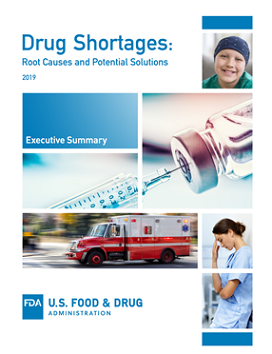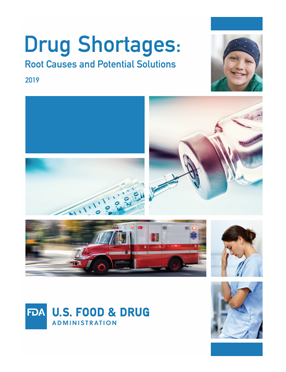Report | Drug Shortages: Root Causes and Potential Solutions
Drug Shortages: Root Causes and Potential Solutions, published in October 2019, examines the underlying factors responsible for drug shortages and recommends enduring solutions. The inter-agency Drug Shortage Task Force, which was led by FDA, oversaw the analysis of drug shortage data and development of recommendations in response to a request from 31 U.S. senators and 104 U.S. congressional representatives in June 2018.
The recommendations were based on insights gleaned from public and private stakeholders at a November 2018 Drug Shortages Task Force Public Meeting, a docket for comments, and listening sessions with stakeholders, as well as FDA data analysis and published research.
The report identifies three root causes for drug shortages:
- Lack of incentives for manufacturers to produce less profitable drugs;
- The market does not recognize and reward manufacturers for “mature quality systems” that focus on continuous improvement and early detection of supply chain issues; and
- Logistical and regulatory challenges make it difficult for the market to recover from a disruption.
The report also recommends enduring solutions:
- Creating a shared understanding of the impact of drug shortages on patients and the contracting practices that may contribute to shortages;
- Developing a rating system to incentivize drug manufacturers to invest in quality management maturity for their facilities; and
- Promoting sustainable private sector contracts (e.g., with payers, purchasers, and group purchasing organizations) to make sure there is a reliable supply of medically important drugs.
In addition, the report describes legislative proposals in the President’s FY2020 Budget and planned FDA initiatives to prevent and mitigate shortages that look at improved data sharing, risk management, lengthened expiration dates for drugs, and internationally harmonized guidelines for a pharmaceutical quality system.
In February 2020, FDA recalculated both the production increase and the extent of supply restoration for drugs that were in shortage between 2013 and 2017. To do so, the Agency used new approaches that better capture whether each drug became more readily available during the shortage. FDA found that 42 percent of the shortage drugs had a significant production increase, meaning that new suppliers entered the market and/or existing suppliers increased their output to an extent that restored at least half of the quantity of the drug that was unavailable during the shortage. Similarly, the Agency found that 30 percent of the shortage drugs had their quantity fully restored to pre-shortage levels. The changes do not affect the Report’s conclusions or recommendations.
The revised text is in two sections:
- Evidence for Root Causes, Events that Happen After Occurrence of a Shortage on pages 36 - 37; and
- Appendix F, Key Findings, Key Finding 3 on pages 119 - 121.


